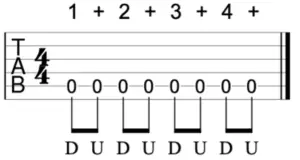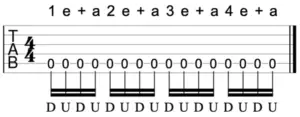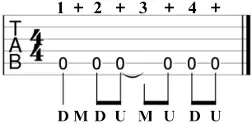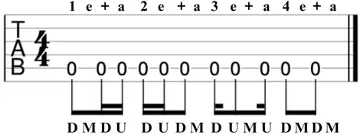The pendulum strum is a game-changing technique for rhythm guitarists, providing the foundation for consistent timing and smooth strumming. This approach emphasizes a steady, continuous motion of your strumming hand, much like the back-and-forth swing of a pendulum. While it may seem simple, mastering the pendulum strum requires practice, attention to detail, and a clear understanding of how rhythm works. In this article, we’ll explore the pendulum strum in and introduce an effective way to “talk” your hand through the motions to develop a natural and precise strumming style.

Why the Pendulum Strum Matters
One of the most common struggles guitarists face is maintaining a consistent rhythm. Many players stop or hesitate their strumming hand when skipping beats or during rests, which disrupts the flow of a song and throws off timing. The pendulum strum addresses this issue by ensuring your hand keeps moving even when you’re not striking the strings. This continuous motion helps you:
- Maintain Timing: Locks in your rhythm with the beat.
- Play Smoothly: Eliminates choppy or hesitant strumming.
- Adapt to Complex Patterns: Makes transitioning between different rhythms easier.
Talking Your Hand Through the Motions
The pendulum strum works beautifully for both 8th-note and 16th-note pulses. Understanding these rhythmic divisions is key to mastering the technique. One of the best ways to practice the pendulum strum is to verbally guide your hand through its motions at a slow tempo. This process helps reinforce the rhythm and ensures that your hand doesn’t stop, even when you’re not striking the strings. Here’s how to do it:
- Understand the Counting System
- For The 8th Note Pulse:
- Each beat is divided into two equal parts.
- The beat is counted as 1 + 2 + 3 + 4 +.
- The hand motions for this rhythm are D U D U D U D U.
- Your foot taps along with every downstroke.

- For The 16th Note Pulse:
- Each beat is divided into four equal parts.
- For 16th note rhythms, the beat is counted as:
1 e + a 2 e + a 3 e + a 4 e + a. - There are four motions per foot tap at this pulse. In other words, tap your foot on the numbers.
- That means the motions within the first beat are D U D U.
- Your foot taps on the first down of each group of four.

- Match the Motions
- Say “down” for every downward strum.
- Say “up” for every upward strum.
- Say “miss” for any motion where your hand moves but does not strike the strings.
- Combine the Words and Motions
For this common eighth-note pattern, keep your hand moving steadily up and down with two motions per beat and say:

For this 16th note pattern, maintain a steady up and down hand movement with four motions per beat and say:

- Practice Slowly
- Begin practicing without a metronome. You want to become familiar with the motions before focusing on playing consistently time.
- Once your hand is keeping a steady up-and-down motion, add in a metronome set to a slow tempo (e.g., 50-60 BPM).
- Speak each motion clearly as you play. This reinforces muscle memory and develops rhythmic consistency.
By “talking” the rhythm, you ensure that every motion has a purpose, even when you’re not striking the strings.
Avoiding Common Pitfalls
Many guitarists struggle with rhythm because they stop their hand when they aren’t strumming. This leads to inconsistent timing and an uneven feel. Here’s how to avoid this:
- Always Keep Moving: The pendulum motion should never stop, even during rests or when skipping strings.
- Use the “Miss” Command: Saying “miss” for unplayed motions ensures your hand stays in rhythm.
- Stay Relaxed: Tension in your hand or arm can lead to jerky movements. Keep your grip on the pick loose and your wrist flexible.
Practice Tips
- Start Simple:Begin with basic 8th note patterns. The 16th note patterns will be much easier once you have a few 8th note patterns down.
- Mute the Strings:Practice with muted strings to focus on your strumming hand without having to hold down or switch chord fingerings.
- Experiment with Dynamics:Once you’re comfortable with the motions, vary the intensity of your strums to enhance expression and musicality.
- Record Yourself:Listening back will help you identify areas where your timing or consistency needs work.
Final Thoughts
The pendulum strum is a cornerstone of rhythm guitar, and learning to guide your hand through the motions with verbal cues can significantly improve your timing and consistency. By counting out loud and practicing at a slow tempo, you’ll build the muscle memory and rhythmic flow needed to tackle any strumming pattern with confidence. Stick with it, and soon the pendulum strum will become second nature, elevating your guitar playing to the next level!
About The Author
Brian Fish is a professional guitarist who has been dedicated to helping other guitar players in Northeast Ohio pursue their musical dreams since 1994. He’s passionate about guiding others on their musical journey! He is the Guitar Playing Transformation Specialist, instructor, mentor, trainer, and coach at Guitar Lessons Geauga.
Brian has also assisted people from around the globe in developing a solid sense of timing and enhancing their creativity through the fantastic rhythm course, “Ultimate Rhythm Mastery,” available at MusicTheoryForGuitar.com.
If you live in Geauga County / North East Ohio, Guitar Lessons Geauga can help you become the player you’ve always wanted to be.

